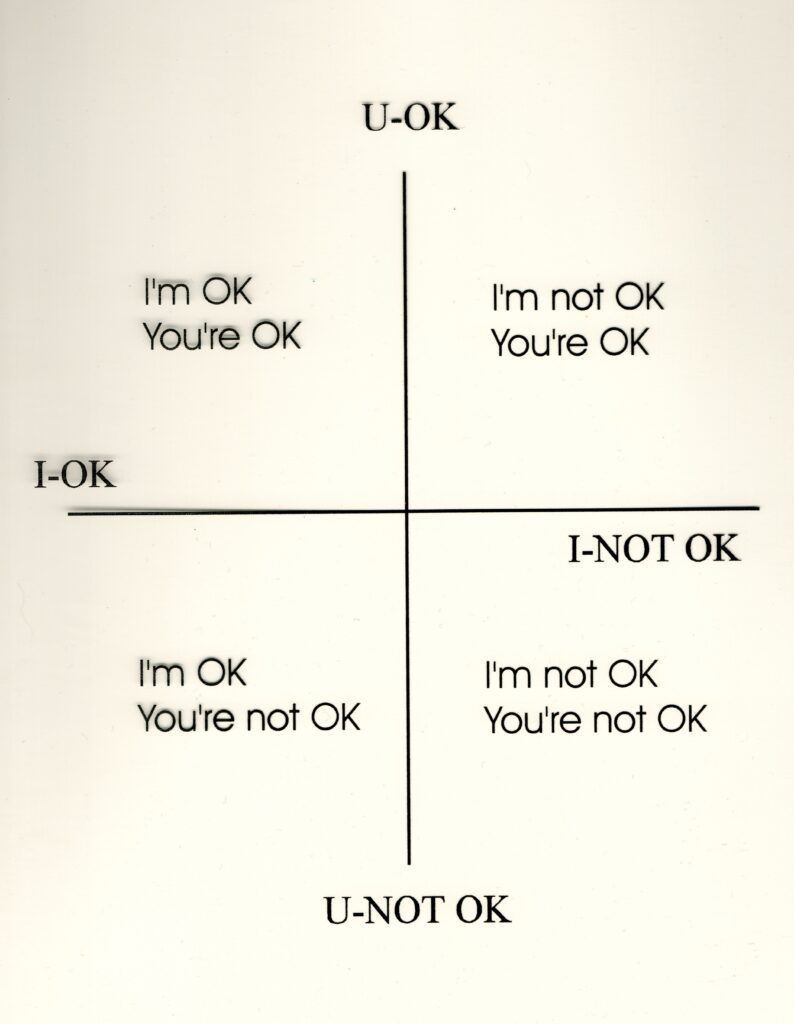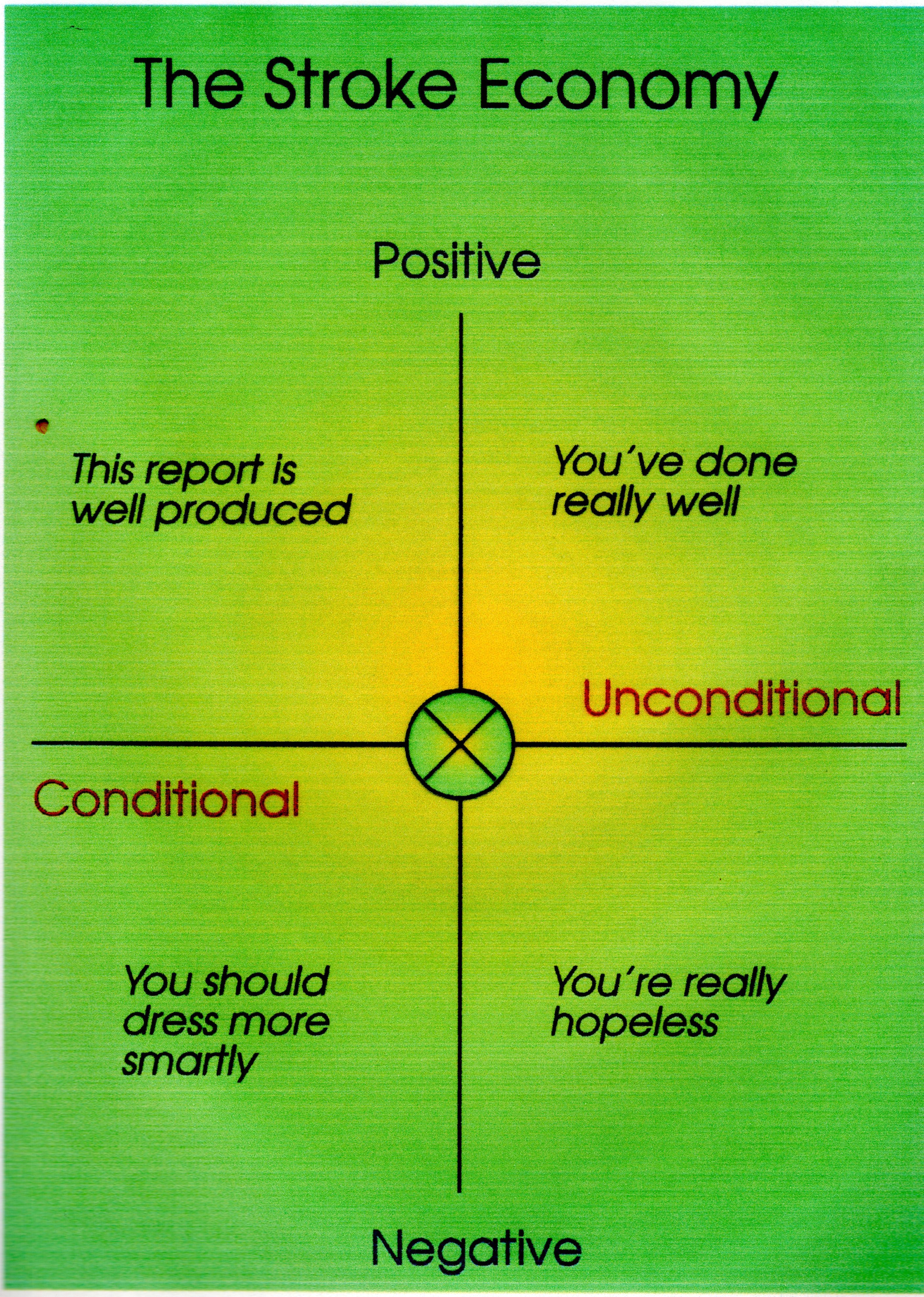The Stroke Economy is another term emerging from Transactional Analysis (TA) into everyday language.
We give and receive strokes with every exchange we have with another human being (and animals, if in a different sort of way!).
A stroke is defined by the founder of Transactional Analysis (TA), Eric Berne (1971), as a unit of recognition. A stroke is a unit of attention that meets an ‘hunger’ I have for stimulation, encouragement, reward and physical and emotional care.
We learn how to give and take Strokes in our formative years. That pattern enters into our adult interactions with other human beings most often without thought or conscious attention.
There are several sites you can visit in order to learn more about various aspects of the Transactional Analytic model. TA is wide ranging and – if my experience is anything to go by – insightful model into human motivation, communication and interaction.
In particular, do follow up on the Drama Triangle, the Driver, the Script and Time Structuring – just a few issues I address on my website. There is a page on the TA Game, and how we might respond differently to ‘inauthentic Strokes’.
Furthermore, you can read about the connection of ‘Stroking’ and Time Structuring via a useful Powerpoint presentation at:
…… but be aware that such sites invite further commitments so be prepared to engage with them only as much, or as little as helps you.
Strokes and small, safe experiments
For the present, I am most concerned about the relevance of the Stroke Economy in the design and implementation of small, safe experiments.
For this purpose, I have reproduced the OK Corral at the head of this page. It described four examples of a positive/negative and conditional/unconditional Stroke pattern. A lot of one, and a scarcity of another, will help me shape my Life Position over several years.
In addition, below, is an illustration of my stroke pattern leading to my ‘Life Position’; that is, how I view my own sense of ‘OKness’ in relation to others:

How might these illustrations help develop some small, safe experiments?
Take a look at both of them. In each case, there are four boxes of roughly the same size.
Choose one matrix to work on and reproduce it on a sheet of paper.
If my examples were ‘your’ drawing, then 25% of your TA Strokes would spread out evenly over the four categories of:
- ‘Stroking’: 25% positive and unconditional; 25% negative and conditional, etc.
- Life Position: 25% of time being I’m OK and you’re OK; 25% of time being I’m not OK and You are OK, and so on.
A SAFE EXPERIMENT with The Stroke Economy
- Make up your own illustration of my matrix, above.
- Create ‘boxes’ that represent the Strokes you receive, as it is in your life, now. I realise it might change day-by-day, and in different situations, so just use your intuition to create a picture of your ‘general’ situation, say, over the last week. It is likely that some boxes will be smaller than others and, indeed, that one box may tend to dominate the picture.
- When you are satisfied that your picture is a good approximation to the situation as it is today then print off a second illustration:
- Then consider this: I have one picture for the Strokes I get. Now what would a second illustration of the Strokes I give look like? Just how different are those two pictures when you personalise them? You will notice that this experiment can be extended to include specific people. This is important, as different Stroke patterns may well emerge with different people.
- After that, consider whether your ‘boxes’ representing the Strokes you get are the ‘size’ you want, and in the ‘right’ proportion for you. Do the same for the Strokes you’d like to receive. You may well find specific examples of Strokes you receive, and Strokes you give that leave you discontent.
- Speculate on how you would prefer it to be – for the Strokes you give and for the Strokes you receive. Possibly, you’d prefer to see more in the positive boxes – conditional or unconditional? Is that really so? If you had 70% of positive, unconditional strokes being offered to you, just how embarrassing might that be!
So this is another advertisement for small changes; see what things can be altered a bit at a time.
ANOTHER SAFE EXPERIMENT in the outside world
- Give unconditional positive strokes where possible. Conditional, positive strokes may be necessary to be specific about a particular ‘good thing’ – and to minimise sounding over-effusive.
- Just notice when you give negative strokes, so you can decide if you can do something a little bit different next time – maybe something more positive.
- Just notice any tendency to hold back from offering positive strokes. The moment passes, and an opportunity may never to be recovered. Can you practise editing your thoughts quick enough to say some just a little bit more positive?
- Where it actually helps to give negative strokes – and it can be necessary – then make the stroke conditional by identifying your specific concern. After that, moderate the negative stroke with a specific reference to how you would prefer it to be.
- Ask for things; that is the antidote to Be Strong. This may take some practise as it is not easy, for some, to give themselves permission simply to ask. Too often we simply wait and hope some-one will mind-read us. Then we may feel disappointed when, as so often, mind-reading does not happen.
- Offer a simple ‘thank you’ when you get a compliment. Even if you are doubtful about some-one’s sincerity, it is still possible to accept strokes directly and clearly. Just notice any uncomfortable feelings and be prepared to edit out the tendency to deflect positive comments made about you.
- Notice unwanted strokes rather than reject them outright as even negative comments from others may be relevant. That’s where the ‘fogging’ experiment can help you. If you take negative strokes to heart then it is easy to over-react towards the other person or, even worse in my view, against your self.
Practise giving yourself a positive and unconditional strokes. Why not think well of yourself in order to practise believing more in those thoughts, bit by bit.
